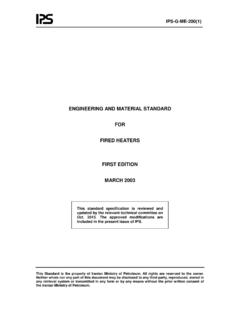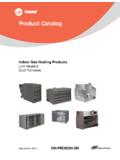Transcription of 02 Engineering Chemical Process Systems - packet-one.com
1 02 Engineering Chemical Process Systems Engineering Chemical Process Systems IDC Technologies Ver UK English 14 Objectives When you have completed study of this chapter you should be able to: Know the various models used to represent the Chemical Process Systems ; Understand the importance of a Process Flow sheet; Prepare a Piping and Instrumentation diagram (P Know the links between a Process diagrams and plant operation; Explain the significance of a plant layout. Process Drawings These drawings are used in the Chemical Process plants to facilitate operations, maintenance and revamp. The technical knowledge needed to run the plant should be contained in the relevant drawings.)
2 Without the drawings, it would be difficult to explain or understand the processes that take place in the Process Industry and it would be even more complicated to try and make repairs or modifications. The purpose of Process Systems drawings: Used by Process personnel to understand or explain a Process Utilized by Process Technicians to repair equipment and understand relationships Referred by Operating staff to become familiar with the Process in a safe environment Provides a Process Technician with visual representation of the Process and equipment All drawings have certain objectives in common: Simplify - Drawings simplify complicated processes by using symbols to represent unit operations. Explain - Drawings illustrate how all the parts or components of a system work together.
3 A drawing can clearly and quickly show the details of a system that might otherwise take many written pages to explain. Practical Fundamentals of Chemical Engineering IDC Technologies Ver UK English 15 Standardize - Drawings standardize information. Each industrial drawing has its unique symbol that represents a specific component. These symbols (with some fine changes) are used globally. If Process personnel are aware of these symbols, this knowledge will allow them to interpret drawings at any Chemical plant . Common Components of Process Drawings All Process system drawings have certain similar components that are universal to drawings.
4 These components include: Legend This is a table that explains or defines all the information of a drawing. The information defined in this table includes: Symbols Abbreviations Numbers Tolerances Any other specific detail Title Block These are normally located in the bottom right-hand corner of drawings. The information included in the title block includes: Drawing number Revision number Drawing title Sheet number Signatures Allowances Application Block Dimensions Shapes Descriptions Engineering Chemical Process Systems IDC Technologies Ver UK English 16 Relative position Material of construction Functions Types of Process Drawings Block Flow Diagrams (BFD) Process Flow Diagrams (PFD) Piping and Instrument Diagrams (P&ID) Electrical Schematics Isometrics Block Flow Diagram (BFD) Theses are the simplest drawings that are used in the Process Industry.
5 They provide a very broad overview of the Process and contain very few specific details. Block Flow diagrams represent sections of the Process as blocks and they show the order and relationship between sections using flow arrows. Block Flow diagrams are useful in getting a high level initial understanding of a Process . ProcessUnit - AInputOutputProcessUnit - BProcessUnit - C Figure Typical Block Flow Diagram Practical Fundamentals of Chemical Engineering IDC Technologies Ver UK English 17 Process Flow Diagram (PFD) A Process flow diagram is one in which all incoming and outgoing materials along with related utilities are indicated.
6 It should be clearly understood that such a diagram is different from the P&ID. Contents of a Process Flow Diagram PFD s essentially illustrates the following: Indicates the critical equipments and instrumentation along with Process conditions of pressure, flow, and temperature. May also include a material balance including compositions of the streams Are used to trace the Process flow through a Chemical plant or refinery Shows all the major equipments and piping, temperatures, and pressures at critical points, and the flow of the Process Represents with symbols, a fluid system and the equipment associated with a fluid system Are valuable to Process technicians because they show how the Process works and the steps associated with the Process It also provides critical information about.
7 The major instruments in each area of the plant and where they are located The kind of equipment and the type of piping used in each stage of the Process The utilities used in a Process PFD s contain information about the following types of equipments utilized in a Chemical Process system : - Vessels - Heat exchangers - Pumps - Compressors - Heaters - Instruments - Valves - Piping Engineering Chemical Process Systems IDC Technologies Ver UK English 18 Generation of a Process Flow Diagram To develop a Process flow diagram a considerable amount of information needs to be gathered. The essential details that needs to be reflected in a PFD are: Flow rate or quantity of each stream Operating conditions of each stream, such as pressure and temperature Heat added/removed in particular equipment Any other specific information, which is useful in understanding the Process From the above, it is clear that the PFD is a very useful diagram in the Chemical Process industry.
8 It effectively communicates design information. It helps the operator in adjusting his parameters, the supervisor in checking/controlling the plant operation. If the basic Process is simple and involves only a few steps, the P&ID and the PFD can be combined into one sheet. Check List for the Preparation of Process Diagrams Identify an equipment arrangement diagram and describe the kinds of information available on it Identify an elevation plan diagram and describe the kinds of information available on it Identify a block diagram and describe the kinds of information available on it Identify a flow diagram and describe the kinds of information available on it Typical Process Flow Diagram A typical Process flow diagram for Lime-Sulphuric Acid recovery Process is shown below.
9 Practical Fundamentals of Chemical Engineering IDC Technologies Ver UK English 19 Sugar NutrientsSulfuric acid H SO24 Fermentationto citric acidConcentrationCrystallizationNeutrali zationFiltrationAcidificationClassificat ionPackagingDecationizationDecolorizatio nLimeFiltrationFiltrationDrying Figure Typical PFD for a Lime Sulphuric Acid Recovery Plant To make it more complete, material and energy balance calculations are required to indicate the flow components into each unit operations and has been excluded to make it more simple. Piping and Instrument Diagram (P&ID) P&ID s are detailed drawings that reflect the piping, instrumentation and equipments along with design information such as piping size and other specifications.
10 P&ID s include: All the equipments used Complete instrumentation methodology Size and type of pipe Design conditions of the equipment Engineering Chemical Process Systems IDC Technologies Ver UK English 20 It contain information about the ways in which piping sections are connected and the instruments associated with the system . P&ID s describe the way in which fluids are directed and controlled. The majority of information about the piping Systems comes from instruments that help control and monitor the system . It is critical that Process personnel know where in the system the instruments are located. They illustrate the equipment in detail and give information on piping dimensions and types.








